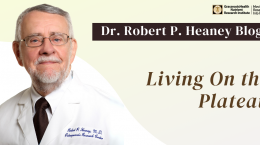Published on February 26, 2024
Dr. Heaney describes two additional physiology-based approaches to defining “normal” nutrient status – something that the currently employed phenomenological approach cannot do
Key Points
- Nutrition policymakers lack a shared vision of “normal” and are forced, therefore, to fall back upon phenomenological or empirical methods to discern and justify nutrient intake recommendations
- The fourth approach to defining a nutrient requirement is, in a sense, a return to our biochemical origins
- The final approach to estimating nutrient requirements is resiliency, or what, in physiology, is termed homeostasis – i.e., the ability of the body to maintain (or restore) a normal value for the various components of our internal environments
 Written by Robert P. Heaney, M.D.
Written by Robert P. Heaney, M.D.
In prior posts I have noted that nutrition policymakers lack a shared vision of “normal” and are forced, therefore, to fall back upon phenomenological or empirical methods to discern and justify nutrient intake recommendations. In those earlier posts (links below) I reviewed briefly three alternatives to this phenomenological approach. In this post I describe two additional methods which, in themselves, may not be widely applicable across the full array of essential nutrients, but which could offer persuasive support for recommendations derived from one or more of the previous three approaches.
Origins
The fourth approach to defining a nutrient requirement is, in a sense, a return to our biochemical origins. It is useful to recall that primitive organisms require very few nutrients. The chemistry of life depends upon a great many chemical compounds, but primitive organisms make most of them for themselves. They can’t avoid dependence on the environment for minerals and energy (since neither can be made). But otherwise they are amazingly self-sufficient. There is, however, an energy cost to making the chemicals of life and most of the energy available to primitive organisms has to be devoted to making what they need to stay alive and reproduce, not to diversify or specialize. The amount they make is effectively equivalent to the amount they need.
When particular environments happen to provide one or more of the required chemical compounds, it is to the organism’s advantage to stop making them for itself, and to depend, instead, upon its particular environment, which provides those compounds, ready-made. Thus, genetic mutations resulting in loss of ability to make a particular compound, while often deleterious, can actually be advantageous if the compound concerned is available in the environment. The mutant organism can use some of the energy no longer needed to diversify and specialize. Over the millennia of biological evolution this process has enabled development of the immense array of living organisms, animal and plant – and ultimately the great apes and humans. Most animals today exhibit extensive dependence upon their environments to provide the chemical compounds they no longer make for themselves. It is these compounds that we call “nutrients”.
How can we use these insights to get at an estimate of how much of those nutrients is needed? One approach is by measuring how much of a particular chemical compound a species’ immediate ancestors made for themselves, just prior (in the evolutionary course of things) to the mutation that led to the first loss of synthetic capacity. This quantity is key, for the energy economy involved in natural selection guarantees that an organism making these compounds of life would not make more than it needed. One wouldn’t need a time machine to find that quantity, since modern molecular biology is able selectively to breed animals in which particular genes have been inactivated. Such animals, lacking the ability to synthesize for themselves a particular essential substance will, therefore, develop a deficiency disease unless the compound needed is supplied in the diet. The amount needed to restore full health is thus that animal’s requirement.
Vitamin C is a perfect – if controversial – example. Vitamin C (ascorbic acid) is absolutely essential for life – so essential that most of the organisms in our environments make their own – most dogs, cats, rats and mice, etc. But somewhere along the branches of the tree of living species, a few animals and many of the primates – including Homo sapiens – lost that ability. The quantity made by the “highest” primate still making its own is an estimate not only of what that species needs, but of how much closely related species, such as humans, might need as well. Even without resort to the tools of molecular genetics, we can study modern mutants. There is, for example, a rat that lacks ability to synthesize ascorbic acid, a contemporary counterpart of an ancestral model animal. Available estimates of its requirement for externally supplied vitamin C are in the range of 30 mg/kg/day.
Of course, when taking this approach it is necessary to make allowance for differences in body size and a host of other factors, such as presence of other compounds able to fulfill vitamin C’s functions. For this reason, precise estimates of the requirement for a particular nutrient may not be possible using this approach alone. Nevertheless, even rough estimates can be useful. For example, if the primate closest to humans made a body size-adjusted 2000–3000 mg of vitamin C daily, it would seem unlikely that the human requirement could be as little as just 2% of that figure. Actually, the official RDA for vitamin C for adult women is exactly that: 60 mg/d (or 2–3% of what may have been the ancestral utilization). Incidentally, the current 60 mg figure reflects only the amount needed to prevent scurvy, not the amount needed to optimize the many metabolic functions of the vitamin. Experts in vitamin C biology have long maintained that simple prevention of scurvy was not the right criterion for nutrient adequacy, that scurvy was actually the manifestation of only the most extreme degrees of vitamin C deficiency, and that its absence, was therefore not the best criterion of adequacy.
Resiliency
The final approach to estimating nutrient requirements is resiliency, or what, in physiology, is termed homeostasis – i.e., the ability of the body to maintain (or restore) a normal value for the various components of our internal environments. As noted in earlier posts, the ultimate function of nutrition is the support of physiological functioning, i.e., ensuring that our bodies have enough of a given nutrient so that a particular physiological process is not limited by nutrient availability. Hence, this issue of resiliency is, in concept, absolutely central to the issue of “normal” nutrition. Can we tap it to gain insights into nutrient requirements?
Tests of resiliency are familiar in the practice of medicine, if not currently used in nutrition. The cardiac stress test is one example. Cardiac response to increased demand for oxygen (induced by walking rapidly on a treadmill) is monitored. The response of the heart to the extra work and the changes it makes to support that work are measures of cardiovascular resiliency. Similarly, a glucose tolerance test involves a deliberate elevation of blood sugar; the test then monitors both how rapidly the body can restore blood sugar to acceptable levels and how much insulin it takes to do that (as well as the ability of the pancreas to put out the needed insulin).
To the extent that various physiological activities may be measurably dependent upon nutrient availability, comparable tests can be devised in which, for example, response to a standardized depletion of the nutrient concerned is measured – reflecting both the status of the nutrient reserve and the availability of redundant or alternative mechanisms to compensate for the induced deficiency.
Because responses to perturbations of homeostasis will almost always involve multiple pathways spread across several body systems, capturing and characterizing these responses will likely be possible only by using the emerging science of metabolomics, still to be widely applied to the understanding of nutrient deficiency. Such responses might involve, for example, changes in concentrations of biomarkers of oxidative stress or inflammation, among many others (such as altered gene expression; see Dr. Patrick McCullough’s comments on Dr. Heaney’s previous blog on this topic here). This is still largely unexplored territory, so of little immediate applicability to nutritional policy. Nevertheless it would seem well worth exploring. Further, altered “-omic” patterns are likely, in themselves (and even without prior perturbation in some kind of test), to reflect relative nutrient status and might thus be helpful in defining “normal”.
Conclusion
In this four-part posting I have described five possible, physiology-based approaches to defining “normal” nutrient status – something that the currently employed phenomenological approach cannot do. Some of these approaches, for at least some nutrients, are ready to use today. Others will require development. All seem worth pursuing.
Nutrition is important – more important than many health professionals seem to believe. The public understands that importance.
Previous Posts by Dr. Heaney
Nutrition Doesn’t Know What “Normal” Is
Thermostats, Feedback, and Adaptation
About Dr. Robert P. Heaney
 Dr. Heaney was a full time professor at Creighton University who also donated his time and energy, starting in 2012 until his passing in 2016, as Research Director at GrassrootsHealth. In this capacity Dr. Heaney consulted on studies, methodologies, and how to best change public health direction. Dr. Heaney provided nearly 50 years of advancements in our understanding of bone biology, osteoporosis, and human calcium and vitamin D physiology. He is the author of three books and has published over 400 original papers, chapters, monographs, and reviews in scientific and educational fields. At the same time, he has engaged nutritional policy issues and has helped redefine the context for estimating nutrient requirements. Dr. Heaney was presented a lifetime achievement award in the US House of Representatives on November 10, 2015 (Watch the video here). He was an inspiration to researchers everywhere – his intellect, dedication, integrity, and caring was unsurpassed.
Dr. Heaney was a full time professor at Creighton University who also donated his time and energy, starting in 2012 until his passing in 2016, as Research Director at GrassrootsHealth. In this capacity Dr. Heaney consulted on studies, methodologies, and how to best change public health direction. Dr. Heaney provided nearly 50 years of advancements in our understanding of bone biology, osteoporosis, and human calcium and vitamin D physiology. He is the author of three books and has published over 400 original papers, chapters, monographs, and reviews in scientific and educational fields. At the same time, he has engaged nutritional policy issues and has helped redefine the context for estimating nutrient requirements. Dr. Heaney was presented a lifetime achievement award in the US House of Representatives on November 10, 2015 (Watch the video here). He was an inspiration to researchers everywhere – his intellect, dedication, integrity, and caring was unsurpassed.
Read more about Dr. Heaney and a few of his accomplishments here.
How Are Your Levels of Important Nutrients?
Do you know what your vitamin D level is? Check yours along with omega-3s, magnesium, and other levels today as part of the vitamin D*action project; add the Ratios for more about how to balance your Omega-3s and 6s!
Measure your:
- Vitamin D
- Magnesium PLUS Elements
- Omega-3 Fatty Acids
- hsCRP (for Inflammation)
- HbA1c (for Blood Sugar)
- and more
Did you know that each of the above can be measured at home using a simple blood spot test? As part of our ongoing research project, you can order your home blood spot test kit to get your levels, followed by education and steps to take to help you reach your optimal target levels. Start by enrolling and ordering your kit to measure each of the above important markers, and make sure you are getting enough of each to support better mood and wellbeing!
Build your custom kit here – be sure to include your Omega-3 Index along with your vitamin D.
Start Here to Measure Your Levels






